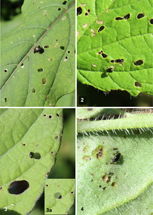Abstract
Thirty-five observations of 25 leaf beetle species and their feeding damage are reported. The beetles belong to 13 genera. Obvious masquerade is found in 29 observations. Nine beetle species in our sample are light in color, but two, being generally light colored, have a wide dark stripe along the elytral suture, so that on the photos (and presumably to visual predators in the field) they appear dark. Feeding damage that these two are surrounded with is also dark. In six observations light colored beetles were making light colored damage. In five examples dark colored beetles were observed among both light and dark colored damage. In remaining observations dark colored beetles were making dark colored damage. Masquerade in Cassidinae and larvae of Alticini and Galerucini is reported here for the first time. In addition, observation of flea beetle interacting with ants on leaf surface and use of feeding holes to move from the upper to the lower leaf surface are reported.
References
- Folgar-Cameán Y., Gómez-Rodríguez C., Konstantinov A. S. & Baselga A. 2021. Hiding among holes: mechanisms underlying the evolution of masquerade in flea beetles (Chrysomelidae). Ecological Entomology 47: 137–145. https://doi.org/10.1111/een.13096
- Konstantinov A. S., Gültekin L. & Gültekin N. 2023. Observations of feeding damage of some Turkish leaf beetles (Chrysomelidae) with new masquerade and host plant records. Journal Insect Biodiversity 37(2): 40–47. https://doi.org/10.12976/jib/2023.37.2.1
- Konstantinov A. S., Prathapan K. D. & Vencl F. V. 2018. Hiding in plain sight: leaf beetles (Chrysomelidae: Galerucinae) use feeding damage as a masquerade decoy. The Biological Journal of the Linnean Society 123: 311–320. https://doi.org/10.1093/biolinnean/blx149
- Prathapan K. D., Konstantinov A. S., Shameem K. M. & Balan A. P. 2013. First record of leaf-hole shelters used and modified by leaf beetles (Coleoptera, Chrysomelidae), with descriptions of two new Orthaltica Crotch species from southern India. ZooKeys 336: 47–59. https://doi.org/10.3897/zookeys.336.5435
- Ren J., de Gunten N., Konstantinov A. S., Vencl F. V., Ge S. & Hu D. L. 2018. Chewing holes for camouflage. Zoological Science 35: 199–207. https://doi.org/10.2108/zs170136
- Skelhorn J. 2015. Quick guide: masquerade. Current Biology 25: R635–R653.


